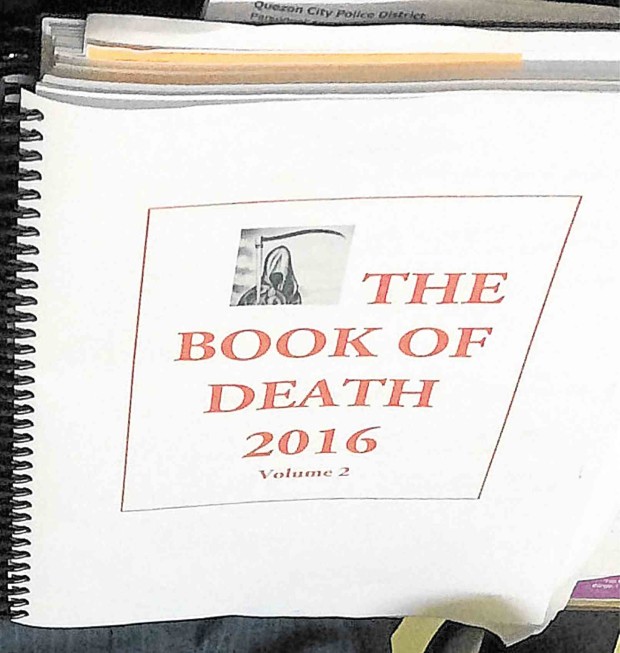Murders he wrote

NO DAINTY DIARY. Senior Insp. Elmer Monsalve writes crime details in a grim-titled book (below) for he believes that “good record-keeping helps solve cases.” ERIKA SAULER
He calls it “The Book of Death.”
The red-lettered title may have a sinister ring to it, but a ranking Quezon City policeman chose it to name a personal project which he says helps him in his job to serve and protect the public good.
On a thick volume of bond paper held together by a black ring binder, Senior Insp. Elmer Monsalve records every killing reported to the Quezon City Police District (QCPD).
Monsalve, the QCPD homicide section chief, enters all the details in handwriting. Neatly.
“In my experience as an investigator, good record-keeping helps solve cases. It’s especially important for backtracking,” Monsalve told the Inquirer in an interview.
Article continues after this advertisementWhile his office keeps digital records of the cases, Monsalve still spends time to write them block-style on his Book of Death, whose title page comes complete with the image of the Grim Reaper. (He also has a bigger version of the macabre image mounted on his office wall, but captioned “Messenger of Peace.” It hangs next to photos of John Lennon, Steve Jobs and Sherlock Holmes.)
Article continues after this advertisementHe started the case compilation in 2011, when he became homicide section chief. Nobody ordered him to do so and police protocol didn’t require it; he just did it as a personal initiative to keep track of the cases.
His recent years in the QCPD have seen several high-profile cases, like the June 2015 ambush that killed car racer Enzo Pastor; the September 2014 home robbery that led to the fatal stabbing of actress Cherry Pie Picache’s mother; and the November 2012 abduction and killing of model Julie Ann Rodelas.

NO DAINTY DIARY. Senior Insp. Elmer Monsalve writes crime details in a grim-titled book for he believes that “good record-keeping helps solve cases.” ERIKA SAULER
A girl’s case
These stories found their way into Monsalve’s pages, cases that have since gained traction or found closure: the Pastor case is now in the court, with the alleged gunman and mastermind in jail; the houseboy who confessed to killing Picache’s mom has been convicted; while four suspects in the Rodelas case were identified and arrested, remarkably, thanks to a McDonald’s receipt that the model was still holding when her body was found.
But what affected him most was the case of a teenage girl who took her own life. The girl’s suicide note included a message addressed to the mom: “I hope you’re happy now.”
The investigation later revealed that, before she committed suicide, the girl earlier asked her mother, a single parent, what the latter wanted for her birthday. The mother purportedly replied: “For you to vanish in my life.”
Revisiting the case made Monsalve tear up.
Being a log or diary of sorts, the book also has entries that reflect what Monsalve called “seasonal death patterns”: People being stabbed during fiestas, dropping dead due to extreme summer heat, or not waking up after a hearty Yuletide feast.
A philosophy graduate from Aquinas University of Legazpi in Albay province, Monsalve keeps a mini library in his office that shows his keen interest in the bigger picture, the hidden angle, or the odd view.
It includes Adrian Raine’s “The Anatomy of Violence: The Biological Roots of Crime,” which says certain physiological signs—such as a bad case of acne, a big gap between the toes or the crease across the palm known as “the mark of Cain”—may indicate the level of a person’s criminal tendencies.
But there’s also the influence of the environment you live in, said Monsalve, offering his own take. “The socioeconomic background is a factor. Informal settler communities are an uncontrolled environment, anything could just happen to you. But in controlled environments like exclusive subdivisions, if something bad happens, it’s usually intentional.”
Sharing another observation, he noted that in upper or middle class neighborhoods “concerned citizens’’ are not hard to come by and will readily provide information to the police when a crime takes place. He usually saw this in Quezon City areas like Eastwood, La Loma, Masambong, Galas and Novaliches.
But in informal settler communities—like those found in Payatas, Batasan and Commonwealth—residents tend to keep mum. “When families don’t talk, they’re often thinking of revenge. So there will be another death the following day,” Monsalve said.
A skilled homicide investigator must therefore be able to convince the victim’s relatives to file a formal case and stop the spiral of violence. “We must let them feel that the police are ready to seek justice and that they should not take justice into their own hands.”
With crime and police crackdowns lately dominating the news because of the ironfisted stance of incoming President Rodrigo Duterte, who has openly called on ordinary citizens to arrest and even shoot suspected drug lords, Monsalve withheld comment on such provocative statements from his next commander in chief.
On the week Duterte was proclaimed winner of the presidential race, at least two male corpses turned up in Quezon City streets, both apparent victims of “salvaging” (summary executions) and bearing signs saying they were killed for peddling drugs.
Is there a new pattern emerging? One thing’s for sure: Monsalve’s Book of Death will keep track, ready with its blank pages.